Karlsruhe Institute of Technology
|
Karlsruher Institut für Technologie | |||||||||||||||||||||||||
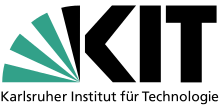 | |||||||||||||||||||||||||
| Type | Public | ||||||||||||||||||||||||
|---|---|---|---|---|---|---|---|---|---|---|---|---|---|---|---|---|---|---|---|---|---|---|---|---|---|
| Established |
Fridericiana Polytechnic: 1825 TU Karlsruhe: 1865 KIT: October 1, 2009 | ||||||||||||||||||||||||
| Budget | € 860.8 million[1]:103 | ||||||||||||||||||||||||
| Chairperson | Renate Schubert[2] | ||||||||||||||||||||||||
| President | Holger Hanselka[2] | ||||||||||||||||||||||||
Academic staff | 5,859[1]:108 | ||||||||||||||||||||||||
Administrative staff | 3,456[1]:108 | ||||||||||||||||||||||||
| Students | 25,196[1]:112 | ||||||||||||||||||||||||
| Undergraduates | 14,136[1]:112 | ||||||||||||||||||||||||
| Postgraduates | 8,181[1]:112 | ||||||||||||||||||||||||
| 664[1]:112 | |||||||||||||||||||||||||
| Location |
Karlsruhe, Baden-Württemberg, Germany 49°00′34″N 8°24′42″E / 49.00944°N 8.41167°ECoordinates: 49°00′34″N 8°24′42″E / 49.00944°N 8.41167°E | ||||||||||||||||||||||||
| Campus | Urban/Suburban | ||||||||||||||||||||||||
| Colors |
| ||||||||||||||||||||||||
| Affiliations | |||||||||||||||||||||||||
| Website | kit.edu | ||||||||||||||||||||||||
The Karlsruhe Institute of Technology (KIT) (German: Karlsruher Institut für Technologie) is a public research university and one of the largest research and educational institutions in Germany. KIT was created in 2009 when the University of Karlsruhe (Universität Karlsruhe), founded in 1825 as a public research university and also known as the "Fridericiana", merged with the Karlsruhe Research Center (Forschungszentrum Karlsruhe), which had originally been established in 1956 as a national nuclear research center (Kernforschungszentrum Karlsruhe, or KfK) .[3]
KIT is one of the leading universities for engineering and the natural sciences in Europe, ranking sixth overall in citation impact.[4] KIT is a member of the TU9 [5] German Institutes of Technology e.V. As part of the German Universities Excellence Initiative KIT was awarded an excellence status in 2006. In the 2011 performance ranking of scientific papers, Karlsruhe ranked first in Germany and among the top ten universities in Europe in engineering and natural sciences.[6] Ranked 26th worldwide in computer science in the internationally recognized "Times Higher Education" ranking, KIT is among the leading universities worldwide in computer science[7].
As of 2018, six Nobel laureates are affiliated with KIT. The Karlsruhe Institute of Technology is well known for many inventors and entrepreneurs who studied or taught there, including Heinrich Hertz, Karl Friedrich Benz and the founders of SAP SE.[8]
History
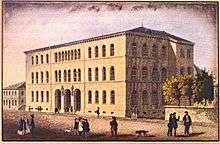
The University of Karlsruhe was founded as a polytechnical school (Polytechnische Schule) on 7 October 1825. It was modelled on the École polytechnique in Paris. In 1865, Grand Duke Friedrich I of Baden raised the school to the status of a Hochschule, an institution of higher education. Since 1902 the university has also been known as the Fridericiana in his honour. In 1885, it was declared a Technische Hochschule, or institute of technology, and in 1967, it became an Universität, a full university, which gave it the right to award regular doctorate degrees. It had hitherto only been allowed to award doctorates in engineering, identified as Dr.-Ing., a right bestowed on all technical institutes in 1899.
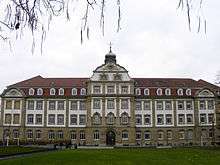
The University of Karlsruhe is one of the leading German institutions in computer science. A central computer laboratory was founded in 1966. The department of informatics was established three years later, along with the first regular course in informatics.[9] On 2 August 1984, the university received Germany's first email. The Institut für Meteorologie und Klimaforschung (Institute of Meteorology and Climate Research) was founded at the university in 1985.
The university also cooperated extensively with the Forschungszentrum Karlsruhe (Karlsruhe Research Centre), and this relationship was formalised on 6 April 2006 when Professor Horst Hippler and Dr. Dieter Ertmann from the University of Karlsruhe, and Professor Manfred Popp and Assistant Jur. Sigurd Lettow from Forschungszentrum Karlsruhe signed a contract for the foundation of the Karlsruhe Institute of Technology (KIT). The name was inspired by the Massachusetts Institute of Technology (MIT), the leading technical university in the United States.[10] In February 2008, the merger of the university and the research centre to form KIT was agreed by the state of Baden-Württemberg and Germany's federal government.[11] The necessary state law was passed on 8 July 2009.[12] KIT was formally established on 1 October 2009.
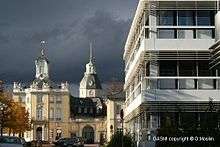
The main reason for establishing KIT was to strengthen Karlsruhe's position in the German Universities Excellence Initiative, which offered elite universities grants of up to 50 million euros per annum. This aim was not achieved. While the University of Karlsruhe was chosen for the initiative in 2006/2007, KIT failed to secure a place in 2012. It did, however, attract funds from other sources. In 2008, Hans-Werner Hector, co-founder of SAP, raised 200 million euros to support researchers at the institute. (Hector is the only founder of SAP who did not graduate from the University of Karlsruhe; he was given an honorary doctorate for his support of intellectually gifted children in 2003.)
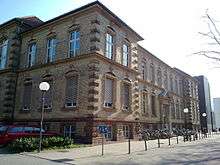
Campus
Campus Nord

The Campus Nord (Campus North), the former Forschungszentrum, was founded in 1956 as Kernforschungszentrum Karlsruhe (KfK) (Karlsruhe Nuclear Research Centre). Initial activities focused on Forschungsreaktor 2 (FR2), the first nuclear reactor built by Germany. With the decline of nuclear energy activities in Germany, Kernforschungszentrum Karlsruhe directed its work increasingly towards alternative areas of basic and applied sciences. This change is reflected in the change of name from Kernforschungszentrum Karlsruhe to Forschungszentrum Karlsruhe with the subheading Technik und Umwelt (technology and environment) added in 1995. This subheading was replaced by in der Helmholtz-Gemeinschaft (in the Helmholtz Association of German Research Centers) in 2002.
Campus Nord is the site of the main German national nuclear engineering research centre and the Institute for Transuranium Elements. Also at the site is a nanotechnology research centre and the neutrino experiment KATRIN.
Campus Nord also hosts a 200-metre-tall guyed mast for meteorological measurements.
Organization and administration
Faculties
The university has eleven faculties:
Academic profile
Education
The university offers a broad range of education options with such possibilities as cross studies and work-study programs. A studium generale (general studies) program was established in 1949, allowing students to attend lectures not directly pertaining their study field.
In the first semesters of a course, education tends to be theoretically oriented at KIT, with a high concentration on mathematics for engineering and natural science courses. It is possible to choose between practical and theoretical topics in later semesters.
Since the winter semester of 2008/2009, KIT has completed the transition from Diplom degrees to bachelor's degrees and master's degrees. Students already enrolled for a Diplom degree when the transition began were allowed to finish their studies, but new students are only allowed to apply for a bachelor's or master's degree.
Admission policies differ among the departments. While students are chosen by the quality of their school degree and their extracurricular activities for courses such as industrial engineering and management (27% of admissions in 2008),[13] other departments do not preselect for their courses, including physics, informatics, and meteorology. All courses require a minimum number of passed exams, called Orientierungsprüfungen or orientation assessments, in the first three semesters before students are allowed to complete their course. There is a substantial drop-out rate in some engineering courses due to the immense study required to meet the prerequisites.
The Zentrum für Angewandte Kulturwissenschaft und Studium Generale (Centre for Applied Culture and General Studies)[14] was founded in 1989 as a central institution to support students engaged in interdisciplinary study. Nowadays, it offers specialised qualifications in the fields of "Leadership and Entrepreneurship", "Media - Culture - Communication", "Internationalisation and Intercultural Decision-making and Responsibility", "Diversity Management", and "European Integration and Identity Studies", as well as the classical studium generale. There is also the possibility of concomitant study in applied culture science.[15]
Research
In 1979, the Interfakultatives Institut für Anwendungen der Informatik (Interfaculty Institute for Informatics Applications)[16] was founded. It brings together research in physics, mathematics, and engineering based on computer science. Its mathematical pendant is the Institut für Wissenschaftliches Rechnen und Mathematische Modellbildung (Institute for Scientific Calculations and Mathematical Modelling).[17] Its aim is to enhance the exchange between mathematics and engineering in the fields of scientific calculations.
The Interfakultatives Institut für Entrepreneurship (Interfaculty Institute for Entrepreneurship)[18] was established with SAP funding. Its teaching professors were entrepreneurs on their own. Before being shut down in 2010, a former professor of this faculty was Götz Werner, founder of dm-drogerie markt.
In 2001, the Centre for Functional Nanostructures (CFN)[19] was established. It merges the fields within material sciences, biology, chemistry, engineering, and physics which are related to nanotechnology. CFN is one of the three Exzellenzzentren (English: Excellence Institutions) of the University of Karlsruhe. Another interdisciplinary institution is the Centre for Disaster Management and Risk Reduction Technology (CEDIM).
The Karlsruhe School of Optics and Photonics (KSOP)[20] was established in 2006 as a publicly funded project by the Deutsche Forschungsgemeinschaft under the German Universities Excellence Initiative. KSOP was the first graduate school at the University of Karlsruhe and covers the fields of photonic materials and devices, advanced spectroscopy, biomedical photonics, optical systems and solar energy. It is supported by several of the university's institutes and professors. It is also a partner in the EUROPHOTONICS consortium,[21] which provides scholarship for master's [22] and PhD degrees[23] under the European Commission's prestigious Erasmus Mundus cooperation and mobility program.
KIT operates several TCCON stations as part of an international collaborative effort to measure greenhouse gases globally. One station is near the campus.
Rankings and reputation
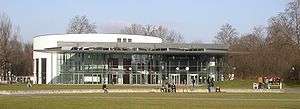
| University rankings | |
|---|---|
| Global | |
| ARWU World[24] | = 201-300 |
| Times World[25] | =133 |
| QS World[26] | =107 |
KIT is one of the leading universities in the engineering and natural sciences in Europe, ranking sixth overall in citation impact.[4] KIT is a member of the TU9[5] German Institutes of Technology e.V. As part of the German Universities Excellence Initiative KIT was awarded an excellence status in 2006. In the 2011 performance-ranking of scientific papers, Karlsruhe ranked first in Germany and among the top 10 universities in Europe in engineering and natural sciences.[6]
In the 2015 QS World University Rankings the Karlsruhe Institute of Technology achieved 93rd place in the global ranking across all disciplines and 62nd and 34th place in engineering and natural sciences, respectively.[27] In the 2013 Taiwan ranking, KIT (world rank 61) retained its position as the best German University in the engineering and natural sciences,[28] ranking in the engineering sciences ahead of the RWTH Aachen (world rank 89), the Technical University of Munich (world rank 94) and the Technical University of Dresden (world rank 108). For the natural sciences KIT (world rank 51) led the domestic comparison against the LMU Munich (world rank 62), the University of Heidelberg (world rank 72) and the Technical University of Munich (world rank 81). Ranked 26th place in computer science in the Times Higher Education Ranking 2016, KIT is one of the leading universities in computer science in Europe as well as worldwide.[29]
According to the Ranking of Scientific Impact of Leading European Research Universities, an official document compiled by the European Commission, Karlsruhe ranks second nationally and sixth in Europe in terms of scholarly impact.[4][30]
With the exception of the department of biology,[31] this university receives more funding from the Deutsche Forschungsgemeinschaft than any other university specializing in the natural sciences in Germany.[32] In the engineering sciences (computer science, electrical and mechanical engineering), the university is in the top three together with the University of Stuttgart and RWTH Aachen. It also consistently ranks top in the industrial engineering and management, with respect to the overall study situation and its popularity with employers.[33]
More than 20% of its students come from other nations and 0.6% of its students receive grants from the German Studienstiftung (German National Academic Foundation).[34] In 1998, Science Watch described its chemistry faculty as belonging to "the cream of the crop in chemistry" internationally.[35]
In 2006, the University of Karlsruhe was chosen to be one of three universities with the best future concept within the scope of the German Universities Excellence Initiative. These universities have been described as "elite universities" in the media and by the general public ever since.
For many years the Department of Computer Science has been the number-one institution in this field in Germany. Hence, the university has established an international reputation.[36]
Computer facilities
The Steinbuch Centre for Computing (SCC), named after Karl Steinbuch, was formed in 2008 when the main computer facilities of the University of Karlsruhe merged with those at Forschungszentrum Karlsruhe. It is responsible for the university's IP connectivity and provides central services (Mail, Web, campus management) for students and employees. It supplies students with 10 fully equipped computer rooms, one professional print office and a wireless network providing access to the whole campus area. Some departments, like computer science, physics, and mathematics, run their own computer facilities as well.
The SCC operates some of the fastest computers in Germany:
- HP XC3000 (334 nodes with 8 cores each, 27.04 TFLOPS)
- HP XC4000 (750 nodes with 4 cores each, 15.77 TFLOPS)
- a cluster purchased by a corporation of institutes representing different disciplines (200 nodes with 8 cores each, 17.57 TFLOPS)
- the two vector parallel calculators NEC SX-8R and NEC SX-9
On 2 August 1984, Michael Rotert, a research fellow at University of Karlsruhe, received the first email ever sent to Germany, at his address rotert%germany@csnet-relay.csnet.[37]
GridKa runs the Rocks Cluster Distribution Linux distribution for supercomputers.
Libraries
The KIT Library with its two branches on Campus South and Campus North provides literature for research and study for about 25,000 students and 8000 scientists with a widespread, interdisciplinary book stock of over 2 million volumes, reports and 28,000 periodicals in print and electronic form. The emphasis of the collection lies in natural and engineering sciences.
- KIT Library South
The 24-hour library at Campus South was extended in 2006. It offers many workplaces and an area for relaxing, and is now open around the clock. The combination of a special book security system and an automated issue desk makes it possible to use the 1000 workplaces anytime, day or night. Current and contemporary literature is freely accessible in four specialised reading rooms, each providing cross-linked, modern and well-equipped study and work stations as well as printers, scanners and copy machines.
- KIT Library North
The research library at Campus North provides a large specialised book stock (especially reports and primary reports) on energy and nuclear energy. All literature is freely accessible to the user. Thirty modern workplaces, as well as printers, scanners, copy machines and cubicles for individual work are available.
- Further libraries at KIT
Additional literature is located in two specialised reading rooms for chemistry and physics, as well as in the Library of the University of Applied Sciences at the Campus at Moltkestrasse, which is administrated by the KIT Library. The faculty of physics, the faculty of mathematics, the faculty of computer science, the faculty of architecture and the faculty of economics and management have their own libraries to supply students and researchers with topic-related literature.
Notable people

Professors
- Karl Ferdinand Braun (1850–1918), who developed the cathode ray tube in 1897, which is widely used in televisions; in 1909 he received the Nobel Prize for the invention
- Wolfgang Gaede (1878–1945), who founded vacuum technology
- Franz Grashof (1826–1893), who significantly contributed to the understanding of free convection; the Grashof Number was named after him
- Fritz Haber (1868–1934), who developed the high-pressure synthesis of ammonia in 1909 and won a Nobel Prize in Chemistry in 1918
- Heinrich Hertz (1857–1894) discovered electromagnetic waves in 1887, which are the basis for radio transmission, and after whom the SI unit of frequency, hertz is named
- Karl Heun (1859–1929), who is known for his work on numerical integration and solutions to differential equations. He discovered the Heun method.
- Otto Lehmann (1855–1922), the founder of liquid crystal research
- Wilhelm Nusselt (1882–1957), the co-founder of technical thermodynamics
- Ferdinand Redtenbacher (1809–1863), founder of science-based mechanical engineering in Germany
- Roland Scholl (1865–1945), discovered coronene and contributed significantly to the field of organic chemistry in general
- Hermann Staudinger (1881–1965), who won the Nobel Prize in Chemistry in 1953 for his discoveries in the field of macromolecular chemistry
- Karl Steinbuch (1917–2005), a pioneer of computer science in Germany who coined the German term for the field, Informatik, and made early contributions to machine learning and artificial neural networks
Alumni
- Johann Jakob Balmer (1825–1898), Swiss mathematician and mathematical physicist
- Karl Benz (1844–1929), the inventor of the automobile, a graduate who also received an honorary doctorate in 1914
- Martin Brudermüller (born 1961), German businessman, CEO of BASF
- Franz Fehrenbach (born 1949), chairman of Robert Bosch GmbH
- Robert Gerwig (1820–1885), civil engineer responsible for the Black Forest Railway, the Gotthard Railway, and the Höllental Railway
- Hans Kollhoff (born 1946), Postmodernist and New Classical architect
- Ludwig Levy (1854–1907), Historicist architect
- Sergey Padyukov (1922–1993), architect
- Wilhelm Steinkopf (1879–1949), University of Karlsruhe alumni and professor, co-developer of a method for the mass production of mustard gas during World War I
- Edward Teller (1908–2003), who is known as the originator of the hydrogen bomb
- Roland Mack (born 1949), co-founder of Europa-Park, one of the most popular theme parks in Europe
- Oswald Mathias Ungers (1926–2007), rationalist architect
- Fritz Noether (1884–1941), mathematician and brother of Emmy Noether
- Hasso Plattner (born 1944), Dietmar Hopp (born 1940), Klaus Tschira (1940–2015), three of five co-founders of SAP
- Stefan Quandt (born 1966), businessman and major BMW shareholder
- Franz Reuleaux (1829–1905), a pioneer of kinematics and rector of the Berlin University of Technology
- Leopoldo Rother (1894–1978), architect who designed the campus of National University of Colombia in Bogotá
- Leopold Ružička (1887–1976), winner of the 1939 Nobel Prize in Chemistry
- Peter Sanders (born 1967), computer scientist who won the Leibniz Prize in 2012
- Amin Shokrollahi (born 1964), Iranian mathematician
- Emil Škoda (1839–1900), the founder of the industrial conglomerate Škoda Works
- Albert Speer (1905–1981), Adolf Hitler's chief architect
- Carsten Spohr (born 1966), CEO of Lufthansa
- August Thyssen (1842–1926), industrialist who founded the steel producer Thyssen AG, a predecessor of ThyssenKrupp, and co-founded RWE, one of the largest German electric utilities companies today
- Ivan Vasilyov (1893–1979), architect of the Bulgarian National Bank headquarters and the Ministry of Defence
- Herbert Wetterauer (born 1957), painter, sculptor, and author
- Rolf Wideröe (1902–1996), Norwegian accelerator physicist
- Dieter Zetsche (born 1953), chairman of Daimler AG and head of Mercedes-Benz Cars
Other
- Georg von Hevesy (1886–1966), winner of the 1943 Nobel Prize for his key role in the development of radioactive tracers to study chemical processes such as in the metabolism of animals, worked with Fritz Haber at University of Karlsruhe without formal appointment
Rectors
- 1968 – 1983 Heinz Draheim
- 1983 – 1994 Heinz Kunle
- 1994 – 2002 Sigmar Wittig
- 2002 – 2009 Horst Hippler[38]
- 2009–2012: Horst Hippler and Eberhard Umbach
- 2012–2013: Eberhard Umbach
- since 1 October 2013: Holger Hanselka[39]
Points of interest
- Botanischer Garten der Universität Karlsruhe, the university's botanical garden
Notes and references
- 1 2 3 4 5 6 7 "Jahresbericht 2015" (PDF). Karlsruhe Institute of Technology (in German). Retrieved 2017-06-10.
- 1 2 Oberdorf, Iris (PKM). "KIT - KIT - Organization - Management and Committees". Archived from the original on 10 July 2015. Retrieved 21 July 2015.
- ↑ Federal Ministry of Education and Research (Germany): "Archived copy" (PDF). Archived from the original (PDF) on 2006-12-01. Retrieved 2015-08-25.
- 1 2 3 "CORDIS: Science and Technology Indicators 2003. Snapshots from the Report: 10. The university model for the 21st century? Published 3/2003, Updated 2/2004" (pdf). Third European Report on Science and Technology Indicators. Retrieved 2017-07-26.
- 1 2 TU9
- 1 2 http://taiwanranking.lis.ntu.edu.tw/Default-EN.aspx%5Bpermanent+dead+link%5D
- ↑ "Karlsruhe Institute of Technology". Times Higher Education (THE). Retrieved 2017-07-11.
- ↑ "KIT's profile at Times Higher Education Ranking". Retrieved 13 November 2016.
- ↑ http://www.informatik.kit.edu/719.php 'History of the department of informatics"
- ↑ Schwägerl, Christian (22 November 2006). "Elite-Institut KIT: „Aus Partnern wird eine Einheit"" (in German). Frankfurter Allgemeine Zeitung. Retrieved 2018-03-29.
- ↑ Federal Ministry of Education and Research (Germany): "Archived copy". Archived from the original on 2008-06-19. Retrieved 2008-08-10.
- ↑ Landtag of Baden-Württemberg: "Archived copy" (PDF). Archived from the original (PDF) on 2009-08-24. Retrieved 2009-08-07.
- ↑ Mohr, Petra (SLE). "KIT - Startseite" (PDF). Retrieved 21 July 2015.
- ↑ Dennis Frerichs. "ZAK - Startseite". Retrieved 21 July 2015.
- ↑ Zentrum für Angewandte Kulturwissenschaft und Studium Generale: Course options Archived 2006-07-03 at the Wayback Machine..
- ↑ "Archived copy". Archived from the original on 2008-09-24. Retrieved 2009-12-12. Interfakultatives Institut für Anwendungen der Informatik
- ↑ Institut für Wissenschaftliches Rechnen und Mathematische Modellbildung.
- ↑ Interfakultatives Institut für Entrepreneurship.
- ↑ Centre for Functional Nanostructures.
- ↑ Karlsruhe School of Optics and Photonics.
- ↑ "Home « EuroPhotonics". www.europhotonics.org. Retrieved 2017-12-26.
- ↑ "KIT - Karlsruhe School of Optics & Photonics - Erasmus Mundus MSc Program". ksop.idschools.kit.edu. 2017-07-25. Retrieved 2017-12-26.
- ↑ "KIT - Karlsruhe School of Optics & Photonics - Erasmus Mundus PhD Program". ksop.idschools.kit.edu. 2017-07-25. Retrieved 2017-12-26.
- ↑ "Karlsruhe Institute of Technology (KIT) - Academic Ranking of World Universities - 2017 - Shanghai Ranking - 2017". www.shanghairanking.com.
- ↑ "Karlsruhe Institute of Technology". Times Higher Education (THE).
- ↑ "KIT, Karlsruhe Institute of Technology". 16 July 2015.
- ↑ "KIT, Karlsruhe Institute of Technology Rankings". Top Universities. Retrieved 21 July 2015.
- ↑ Simon Scheuerle. "KIT - Das KIT - Medien - Presseinformationen - PI Archiv - PI 2013 - KIT mit Top-Ergebnissen im Taiwan-Ranking". Retrieved 21 July 2015.
- ↑ "KIT's ranking in computer science in the Times Higher Education Ranking 2016". Retrieved 13 November 2016.
- ↑ "CORDIS: Science and Technology Indicators: full version". Third European Report on Science and Technology Indicators. Retrieved 2008-05-16.
- ↑ "DFG - Deutsche Forschungsgemeinschaft - 404 Seite nicht gefunden" (PDF). Retrieved 21 July 2015.
- ↑ Exzellent in Naturwissenschaften. 03.07.2003 Archived 2008-04-05 at the Wayback Machine.
- ↑ Toussaint, Frederic (WIWI). "wiwi-Study and education - Lehrqualität". Retrieved 21 July 2015.
- ↑ "Hochschule: Die Eliteschmiede". ZEIT ONLINE. Hamburg, Germany: GmbH. 8 September 2005. Retrieved 21 July 2015.
- ↑ ScienceWatch: Chemistry Research. Institutions Ranked by Citations and Citation Impact. July/August 1998
- ↑ References Archived 2012-08-03 at Archive.is
- ↑ "Vor 25 Jahren: Die erste E-Mail erreicht Deutschland - cio.de". Retrieved 21 July 2015.
- ↑ Office of the President of Universität Fridericiana Archived 2009-09-12 at the Wayback Machine.
- ↑ Senat bestätigt die Wahl von Holger Hanselka, Press release 078/2013 of the KIT
External links
| Wikimedia Commons has media related to Karlsruhe Institute of Technology. |
.svg.png)